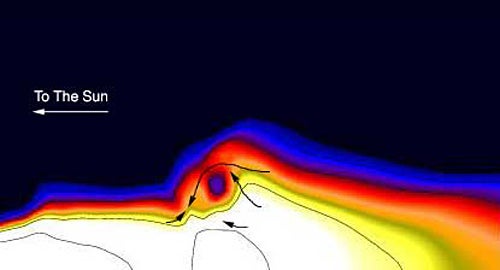Dynamic simulations of the early solar system show giant shock waves surfing across the protoplanetary disk from the orbit of Jupiter and striking circling dust grains with enough speed to fuse them. The result is chondrules, millimeter-size beads that make up the bulk of rocky meteorites and play an important role in planet formation.
For more than a century, astronomers and meteoriticists have debated how chondrules formed. These simulations from two independent research groups go a long way toward solving that 130-year old riddle. Recently, melting by shock waves emerged as the leading theory. What the theory lacked was a convincing mechanism for generating those waves.
The missing mechanism has now surfaced in state-of-the-art simulations of the rotating disk of gas and dust that spawned the solar system. Teams led by Alan Boss at the Carnegie Institution of Washington and Richard H. Durisen at Indiana University performed the studies, which appear together in the March 10, 2005, issue of The Astrophysical Journal.
In both models, spiral arms and massive clumps of gas form in a gravitationally unstable zone near Jupiter’s orbit. These clumps create enormous waves that spiral across the surface of the protoplanetary disk. In the inner disk the waves pile up into shock fronts, like breakers hitting a beach.
“Sometimes the waves form tubes similar to breaking ocean waves,” says graduate student Aaron Boley, part of Durisen’s group. “Except these tubes are nearly 1,000 Earth diameters wide,” or 8 million miles (13 million km) across.
When dust grains “slam into the backside” of these shock waves at orbital speed — around 20,000 miles per hour (32,000 km/h) — they are flash-heated and fuse into chondrules.
Durisen and Boss are particularly pleased that their findings link the formation of the solar system’s tiny chondrules and gas giants so naturally. They believe this “possible unified scenario” of planet formation should apply in any system that spawns a gas giant like Jupiter.
“It seems to me that gas giant planet formation is commonplace,” says Boss. “Hence, I would argue that chondrule processing … should be equally commonplace.” Those chondrules “would then accumulate to form their terrestrial planets and asteroid belts.”
Although neither group claims to have completely solved the chondrule conundrum, they are encouraged by their findings. “I think that the mechanism that Dick and I have advanced to generate these shock fronts is almost unavoidable,” says Boss.
Durisen is a touch more cautious. “I see it as suggesting a unifying hypothesis that needs to be fleshed out,” he says. “Old mysteries do not give up their secrets easily.”
Harold Connolly Jr., a meteoriticist at Kingsborough College of the City University of New York, applauds their work. “The major issue was that the shock wave model matched the record [of heating and cooling], but you didn’t know what produced those shocks,” he says. “They have provided the mechanism to make those shocks, and in a very convincing fashion.”










